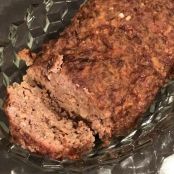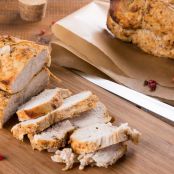Easier Roast Turkey and Gravy
By á-141726
We loosen the skin of the turkey and apply a mixture of salt and sugar to the meat to season it and help it retain more juices as it cooks. A baking powder rub ensures thorough browning and crispy skin. We preheat both a baking stone and a roasting pan in the oven before placing the turkey in the pan. The stone absorbs heat and delivers it through the pan to the turkey’s legs and thighs, which need to cook to a higher temperature than the delicate breast meat (which we protect with a foil shield). After the leg quarters have gotten a jump start on cooking, we reduce the oven temperature from 425 to 325 degrees and remove the shield to allow the breast to brown while the bird finishes cooking. The boost of heat provided by the stone also helps the juices brown and reduce into concentrated drippings that can be turned into a flavorful gravy in the time that the turkey rests.
Ingredients
- Kosher salt and pepper
- 4 teaspoons sugar
- 1 (12- to 14-pound) turkey, neck and giblets removed and reserved for gravy
- 2 1/2 tablespoons vegetable oil
- 1 teaspoon baking powder
- 1 small onion, chopped fine
- 1 carrot, sliced thin
- 5 sprigs fresh parsley
- 2 bay leaves
- 5 tablespoons all-purpose flour
- 3 1/4 cups water
- 1/4 cup dry white wine
Details
Servings 10
Adapted from americastestkitchen.com
Preparation
Step 1
Note that this recipe requires refrigerating the seasoned bird for 24 to 48 hours. This recipe was developed and tested using Diamond Crystal Kosher Salt. If you have Morton Kosher Salt, which is denser than Diamond Crystal, reduce the salt in step 1 to 3 tablespoons and rub 1 tablespoon of the salt mixture into each breast, 1 1/2 teaspoons into each leg, and the remainder into the cavity. If using a self-basting turkey (such as a frozen Butterball) or a kosher turkey, do not apply the salt-mixture to the bird. The success of this recipe is dependent on saturating the baking stone and roasting pan with heat.
1. Combine 4 tablespoons salt and sugar in bowl. Place turkey, breast side up, on counter. Using your fingers, carefully loosen skin covering breast and legs. Rub 4 teaspoons salt-sugar mixture under skin of each breast, 2 teaspoons under skin of each leg, and remaining salt-sugar mixture inside cavity. Tuck wings behind back and tie legs together with kitchen twine. Place turkey on wire rack set in rimmed baking sheet and refrigerate, uncovered, for 24 to 48 hours.
2. At least 30 minutes before roasting turkey, adjust oven rack to lowest position, set baking stone on rack, set roasting pan on baking stone, and heat oven to 500 degrees. Combine 1 1/2 teaspoons oil and baking powder in small bowl. Pat turkey dry with paper towels. Rub oil mixture evenly over turkey. Cover turkey breast with double layer of aluminum foil.
3. Remove roasting pan from oven. Drizzle remaining 2 tablespoons oil into roasting pan. Place turkey, breast side up, in pan and return pan to oven. Reduce oven temperature to 425 degrees and roast for 45 minutes.
4. Remove foil, reduce oven temperature to 325 degrees, and continue to roast until breast registers 160 degrees and drumsticks/thighs register 175 degrees, 1 to 1 1/2 hours longer.
5. Using spatula, loosen turkey from roasting pan; transfer to carving board and let rest, uncovered, for 45 minutes. While turkey rests, using wooden spoon, scrape up any browned bits from bottom of roasting pan. Strain mixture through fine-mesh strainer set over bowl. Transfer drippings to fat separator and let rest for 10 minutes. Reserve 3 tablespoons fat and defatted liquid (you should have 1 cup; add water if necessary). Discard remaining fat.
6. Heat reserved fat in large saucepan over medium-high heat until shimmering. Add reserved neck and giblets and cook until well browned, 10 to 12 minutes. Transfer neck and giblets to large plate. Reduce heat to medium; add onion, carrot, parsley sprigs, and bay leaves; and cook, stirring frequently, until vegetables are softened, 5 to 7 minutes. Add flour and cook, stirring constantly, until flour is well coated with fat, about 1 minute. Slowly whisk in reserved defatted liquid and cook until thickened, about 1 minute. Whisk in water and wine, return neck and giblets to pan, and bring to simmer. Simmer for 10 minutes, then season with salt and pepper to taste. Discard neck. Strain gravy through fine-mesh strainer, discarding solids, and transfer to serving bowl. Carve turkey and arrange on serving platter. Serve with gravy.
Salting Under the Skin
In order to apply salt to turkey flesh, the skin must first be loosened. Here are a couple of tips:
1. Don’t detach the membrane along the breastbone— it’s hard to loosen without ripping the skin. Plus, the membrane helps you divide the salt evenly.
2. The skin around the curve at the neck end can be difficult to loosen. To make the job easier, first loosen the skin on the bottom two-thirds of the breast and the legs, and then turn the turkey 180 degrees and come in through the neck end to loosen the skin on the top third of the breast.
Note: Don’t forget to salt the cavity of the bird as well; when we skipped this step, the turkey didn’t taste as deeply seasoned.
1. Working from tail end, rub salt under loosened skin on bottom two-thirds of breast and legs.
2. Working from neck end, rub salt on remaining breast meat.
You'll also love
-
 PINK LEMONADE VODKA SLUSH
0/5
(0 Votes)
PINK LEMONADE VODKA SLUSH
0/5
(0 Votes)
-
 Spinach and Cheese Crostini
0/5
(0 Votes)
Spinach and Cheese Crostini
0/5
(0 Votes)
-
 Sausage Egg Roll in a Bowl
0/5
(0 Votes)
Sausage Egg Roll in a Bowl
0/5
(0 Votes)
-
 Honey Garlic Dijon Pork Tenderloin...
5/5
(1 Votes)
Honey Garlic Dijon Pork Tenderloin...
5/5
(1 Votes)
-
 Turkey Coney Island Meat Sauce for...
0/5
(0 Votes)
Turkey Coney Island Meat Sauce for...
0/5
(0 Votes)



Review this recipe